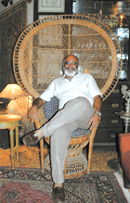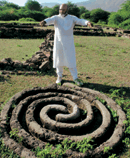


|
Baroda's Bon Vivant!
Karan Grover is Mr. Baroda... the foodie who is determined to rebuild the city and who retrieved Champaner from its ruins and presented the lost city back to civilisation. MARK MANUEL gets to know and like the man all Baroda is singing praises of. |
|
Perhaps it was his enthusiasm to get us among the ruins of Champaner that made Karan drive like that. Or, else, he was just a speed fiend. But he certainly did not have an eye on the speedometer all during the drive, for he concentrated on telling me about his beloved Champaner over the distance. This is the same man who, the previous night, had fussed over his kitchen staff in his passion and enthusiasm to present a gourmet meal of signature dishes to me and an eclectic table of his close friends from Baroda’s society. There was the royal couple of Baroda, Maharaja Ranjitsingh and Maharani Shubhangini, their son and daughter-in-law, Samarjitasingh and Radhikaraje, the painter Rini Dhumal and her architect daughter Radhika, Jal Patel, former MD of FAQ Precision Bearings, Kamal and Phiroze Patel (who feature subsequently in this magazine) and friends Priti and Vimal Patel. That was Karan Grover’s guest list. He generally invites people he interacts with during the day on work, professionals like educationists, artists, architects, and he is particular about wanting to have good and interesting food on his table. The ground rule is that everything must be made at home. Nothing is ordered from out. He might try out a new dish and get it polished till he feels comfortable serving it to others. He believes that food and conversation is what tie people together. So that night, the menu was: Chicken Saabz, Kheema Biryani, Chingri Daab, Chole, Sindhi Parathas and an outstanding Apricot Pudding made by Karan’s dusky, beautiful and elegant wife Nisha. She has been a teacher in a special school for the hearing impaired for 31 years. And while she shares Karan’s fascination for food, and is creative and brilliant in her own way at setting up a dinner menu, Nisha admits to not having her husband’s patience. “He would have made a good cook if he had the time. For whatever Karan does, he gets involved in totally, and he wants to get it right. If he’s making scrambled eggs, he will do them in olive oil and add pesto sauce to the dish. I like to experiment. But I don’t think food all the time. I supervise the home cooking.”
Fortunately, Baroda has great outdoor caterers, and they offer the possibilities of holding large parties with a choice of food. The entertaining season is winter. �We are packed and there is not a day off,� grumbles Nisha. �I would prefer the parties to be spread through the year but the monsoon and summer are dull.� The city�s Maharaja Sayajirao University attracts a lot of artists and writers and the Grovers meet them often in intimate gatherings that would not be possible in a big city. Baroda has a cosmopolitanism and openness about it that makes the city hospitable and encourages its people to do things that are different from other big cities in Gujarat. �Winter is very pleasant here,� says Nisha, �there are garden parties around bonfires, Christmas and New Year are big occasions, Navratri is bigger, it is the start of the festive season, girls and boys move around easily, it is a nice feeling, very safe and secure, there are celebrations everywhere, and some of the home parties are even with dancing and DJs.�
Again, this is the same man who works hard and parties harder. “I lead a mad life in terms of work. I put in hours that another man would find difficult to do. And I find having and organising a party relaxes me. Doing the flowers, having an exotic arrangement, is a major thrill. I have been laying the table for years. And I break tradition. For example, I could use cheap terracota candlestands from Goa that cost 20 bucks with the most expensive crockery from Germany. I like to mix cultures and material. Riedel wine glasses from Austria with Faridabad glass plates. I don’t believe a thing has to be complicated and expensive for it to be good. Also, I never repeat a setting. Everytime, I do something new. I never repeat colours or textures. I am fastidious about things at a party going the way they should. I give great amount of time and put in lot of effort to make sure this happens. I also have a great eye for detail. Any guest that makes a comment at my party, specifies a preference for a particular wine, or a weakness for some kind of food, I will always remember. And even if that guest comes five years later, I will have that wine and food for them. People are touched that I care about these things. But I have always maintained that relationships among people are very important. And I make an effort to sustain relationships. I’m old fashioned, perhaps, but I like parties to have everything right — especially food and conversation, that’s the soul.” Karan, who stood in the kitchen over our dinner making sure his cook got our meal right, is also of the firm conviction that a menu can be underplayed but each fragrance and taste of the food must be special and precious to his guests. “I am now beginning to cook,” he says smugly. “So long, I was a back-seat driver. I never wanted to do something I was not good at. I did not have enough practise, the riyaaz, but for doing things like pastas and salads, and anything with eggs. I have an eye for detail. And I can tell you about food, how good a dish is and how compatible its ingredients are, much before tasting it. But now I am trying to overcome my fear for getting things right the first time. I am learning to try and cook food and not feel bad or a lesser person if I mess up the dish.” It is this same will to do the best he can with his incredible amount of energy that Karan Grover carries into his profession as one of Baroda’s and India’s top architects. The man has won every major architecture award there is to be won. And yet, he remains a simple guy. A man with old fashioned values who loves people and who has no hidden agendas. “Determination, perseverance, the belief that what I am doing is what I should be doing, these principles give me the energy to love the things I do,” he says about himself. In Baroda, among his contemporaries and friends, Karan is known to be a sincere and exceptionally hard-working architect who tries to see life through the eyes of his clients in his practise. I saw some part of this when we reached Champaner after a hair-raising and breath-taking drive of about 45 minutes during which Karan neither let up on the conversation nor did he relax his foot on the accelerator. Now Champaner, I am told, is one of the finest examples of medieval architecture in India. It is said to be ranked by historians with the same significance as, say, the other two medieval capitals of Fatehpur-Sikri and Hampi-Vijaynagar. They are all World Heritage Sites. Champer has several notable monuments, which include fortifications, palaces, religious buildings, residential precincts and water installations. Its Jami Masjid, which is a perfect blend of Indo-Islamic work and is featured in the Encyclopedia of World Architecture, is considered to be one of the most important monuments in India in the development of mosque architecture in the world. Champaner, a book on the medieval capital says, is perhaps the most authentic Islamic, pre-Mughal medieval city in India as all the information about the original city, without any transformation, is available below the ground. No surprise, then, that Champaner was described by UNESCO as the only complete and unchanged Islamic pre-Mughal city and conferred the status of a World Heritage Site in July 2004. This was part of Karan Grover’s dream. As a 22-year-old architecture student who swam the 100, 200, 400 and 1,500 metres freestyle at national level for the Maharaja Sayajirao University, he was one day taken aside by an Australian coach and told, “You can either be an Asian swimmer or an architect.” Karan chose architecture because at that time, Prof. R. N. Mehta from whom he was inseparable, and who had recovered Champaner from the ruins, had told him, “I am giving you Champaner. I will groom you to take over.” That was 30 years ago. And the young Karan, who had boundless energy and tremendous confidence even then, had told Prof. Mehta, “Sir, I’ll make Champaner a World Heritage Site.” According to Karan, Champaner was always there in the shape and form of 30 buildings that were protected by the Archaeological Society of India. �But 115 buildings, a whole city, were lying buried. �When you excavate and don�t look after a site, it gets covered with earth. Look at what happened to Pompei,� he says. Prof. Mehta passed away and left his whole trunk on Champaner for Karan. �I inherited it. And I made it my life�s mission to try and make Champaner a World Heritage Site. Prof. Mehta was an archaeologist. He did his job, which was excavation. But what was left to be done had to be done by me. I restored Champaner. How much is left? A whole city! About 2,000 buildings�
|

Home Page
 Karan Grover believes accelerators are meant to be stepped on. He kept his heavy foot that was clad in an expensive track shoe firmly pressed down on the accelerator of his car, and we zipped from Baroda to Champaner, the city he rediscovered for the world, in a matter of 40 minutes.
Karan Grover believes accelerators are meant to be stepped on. He kept his heavy foot that was clad in an expensive track shoe firmly pressed down on the accelerator of his car, and we zipped from Baroda to Champaner, the city he rediscovered for the world, in a matter of 40 minutes.  The Grovers have a cook who has been trained to turn out meals exactly the way Karan wants them to be served. Nisha says, �He is very demanding even on an every day basis. Nothing ordinary will do for Karan.� As a result, even simple Indian meals at their warm and cosy home have a designer taste and appeal about them. An Indian non-vegetarian main course dish would be treated in a Western way and given additions like a vegetable side dish and salad. �Like tandoori fish served with sauteed potatoes and spinach,� suggests Nisha helpfully. �And when we are entertaining, then Karan gets into the menu planning completely. I have ideas too, but not his patience.�
The Grovers, like most other Baroda families, also believe that home parties are worth taking great pains over. �There�s not much entertainment here by way of theatre, no clubs, and people are left to their own resources. Prohibition in the city has changed the complexion of entertainment. So home parties are fun! We have been doing them for 26 years,� says Nisha.
The Grovers have a cook who has been trained to turn out meals exactly the way Karan wants them to be served. Nisha says, �He is very demanding even on an every day basis. Nothing ordinary will do for Karan.� As a result, even simple Indian meals at their warm and cosy home have a designer taste and appeal about them. An Indian non-vegetarian main course dish would be treated in a Western way and given additions like a vegetable side dish and salad. �Like tandoori fish served with sauteed potatoes and spinach,� suggests Nisha helpfully. �And when we are entertaining, then Karan gets into the menu planning completely. I have ideas too, but not his patience.�
The Grovers, like most other Baroda families, also believe that home parties are worth taking great pains over. �There�s not much entertainment here by way of theatre, no clubs, and people are left to their own resources. Prohibition in the city has changed the complexion of entertainment. So home parties are fun! We have been doing them for 26 years,� says Nisha.
 Festive occasion or simple, home dinner, Karan Grover believes that food appeals to all the senses. “A good recipe does not always mean a good dish unless it is presented well, in the correct plate, and with the right setting,” the world renowned architect says. “When entertaining or even just dining at home, I am involved in totality with the experiernce. I have carried huge silver salvers back home from across the world knowing in the general scheme of things what food I will one day present in them. I conceive menus. I am passionate about food. I eat all over the world. But I don’t leave it at that. If I like a particular dish, I make it my business to find out more about it. I befriend chefs, I get the recipes from them, I buy cookery books, I take time to study and celebrate food. There is no limit to what I will do. I pursued a set of Versace plates that I had seen in Dubai. It took me five years to order. But I got the plates the day Versace was shot dead! And do you know what excited me about these dinner plates? The fact that Versace had used the peacock on them. It’s our national bird! I once saw a beautiful wine decanter in a picture and searched all around the world for it. Ultimately, I bought it at Harrods. I am not after a quick fix. I can wait years to get what I want,” Karan says about himself.
Festive occasion or simple, home dinner, Karan Grover believes that food appeals to all the senses. “A good recipe does not always mean a good dish unless it is presented well, in the correct plate, and with the right setting,” the world renowned architect says. “When entertaining or even just dining at home, I am involved in totality with the experiernce. I have carried huge silver salvers back home from across the world knowing in the general scheme of things what food I will one day present in them. I conceive menus. I am passionate about food. I eat all over the world. But I don’t leave it at that. If I like a particular dish, I make it my business to find out more about it. I befriend chefs, I get the recipes from them, I buy cookery books, I take time to study and celebrate food. There is no limit to what I will do. I pursued a set of Versace plates that I had seen in Dubai. It took me five years to order. But I got the plates the day Versace was shot dead! And do you know what excited me about these dinner plates? The fact that Versace had used the peacock on them. It’s our national bird! I once saw a beautiful wine decanter in a picture and searched all around the world for it. Ultimately, I bought it at Harrods. I am not after a quick fix. I can wait years to get what I want,” Karan says about himself.